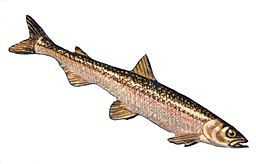Pacific Rainbow Smelt

Species Details
Osmerus Dentex
Osmeridae
Osmeriformes
Nearshore, Rivers, Streams, Estuaries, Lakes, Lagoons
5 - 7 lbs.
5" - 13"
Pacific Rainbow Smelt (Osmerus Dentex) Description
The Pacific Rainbow Smelt is a small brackish water fish that can be found in boreal places. They have canine-like teeth and their body is slender and cylindrical. They are primarily olive in color with a silvery side. Along with its side is a longitudinal hue of olive, pink, blue, and yellow, which is where they got their name rainbow smelt. On their upper side, it's grey to black and their rays are soft.
Size and Diet
On average, The Pacific rainbow smelt is only 5 inches. Their maximum size is 13 inches long. They eat insects, larvae, worms, and fishes. Their average weight is only 3 ounces. The current heaviest Pacific rainbow smelt is currently unknown.
Interesting Facts About the Pacific Rainbow Smelt
- This fish was once considered a subspecies of the rainbow smelt (Osmerus mordax), later on, it was categorized as a different one, Osmerus dentex. The rainbow smelt (Osmerus mordas) are restrictedly found in the east coast of Canada and the North American Great Lakes. Whereas the Pacific rainbow smelt is found on the western side.
- This fish has an antifreeze protein and glycerol, which is why they can survive the harsh cold temperatures.
- This species is anadromous. They migrate from freshwater to sea waters as adults and comes back to freshwater to spawn, like trouts. Spawning is the only reason why they enter the rivers or streams.
- Among anglers, the Pacific rainbow smelt is popular gamefish to eat. They’re usually fried with batter and eat them like French fries or like fish and chips.
- People in Canada and Alaska also catch this game fish by using long nets when they’re in season. In some places, they even have ice shacks specifically for this fish during the winter.
Fishing Techniques: How to Fish the Pacific Rainbow Smelt
One of the best ways to fish a Pacific rainbow smelt is through ice fishing. Look for places where the ice is slushy, this will be a good spot to break the ice. They’re known to be aggressive biters and are very easy to catch. So don’t you worry, you’ll get one for sure. Set your rig slowly from the surface or up to 20 feet. Lower it down every 2-3 feet if you’re not catching any. If you catch one at a certain depth, stay on that level. If ice fishing is not viable, you can still fish them by sight casting.
With a fish as small as the Pacific rainbow trout, use ultralight or featherweight rods so you would notice if the tiny smelts take your bait. A good size for the rods is around 4-5 feet long. Anglers usually use a sensitive line with a 2-4 lbs test.
Use tiny hook sizes of 18 to 14 for this small fish. For lures, the best to use are spring bobbers, teardrops, and hair jigs. For Baits – bloodworms and maggots are the way to go.
Habitat and Distribution
The Pacific Rainbow Smelt is scatted across the northern hemisphere of the globe. It has a large range from the Arctic Ocean to the Pacific Ocean– from European waters to Japan and Korea. In the United States, they can be found on the northwestern side. It’s a schooling species that thrive in cold waters with temperatures of 35.6° to 39.2°F. They spawn in shallow streams or rivers with depths of 6 inches to 1.6 feet. They can also be found in lakes, lagoons, estuaries, and nearshore.
Spring is Their spawning season, They’re more abundant in April to June once the ice starts to melt. They spawn their eggs in temperatures of 44.6° to 57°.2 F. While the eggs hatch between 41° to 64.4°F. In the sea, they in shallow waters of 13 to 27 feet. Good fishing spots are located in Alaska and Canada, such as the Gulf of Alaska, Chukchi Sea, Vancouver Island, and Coronation Bay. There are also spots in northern Seattle, such as Port Angeles.







